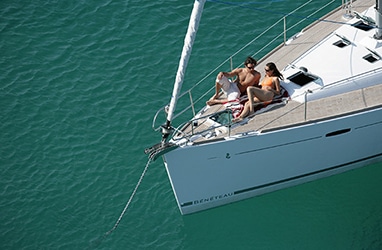
This article is an excerpt from NauticEd’s Bareboat Charter Course, a comprehensive online course that equips you with all the necessary skills and knowledge to successfully charter a yacht. The Bareboat Charter course is part of the Bareboat Charter Master bundle of online courses, fully preparing you for near-coastal sailing and sailing charters.
You can learn to sail and improve your sailing with NauticEd, the international leader in sailing education.
Fishing on a Charter
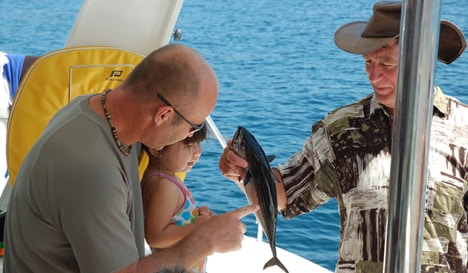
Bring a fishing rod and reel with a 20 lb break strength line. Even if you’re not typically a fisher, few things in life are better than catching a fish for your crew, cooking it, and serving it that evening. It will increase your hero status. Also from home, bring a tube of Wasabi sauce for Tuna if you catch one. Many of the local grocery stores don’t sell Wasabi and a Tuna can make your sushi lover’s eyes pop out when they see $300 worth of Sashimi in front of them.
While you should take a couple of lures from home or buy them at your next local boat show you should really plan on using lures that you buy at the local port area. Local lures catch local fish. But… oftentimes the base is remote and a local fishing store is not close by. Thus, bring a few backups. The best kind to get is a diving one so that it does not skip across the surface. This one below works well as it is designed to dive. These types also create a lot of drag so your rod will need to be pretty stiff. Make sure you ask the base to install a rod holder onto the stern rails.
This little Tuna fed us for lunch and dinner. Notice, however, that his head was taken off by a shark on the way in.
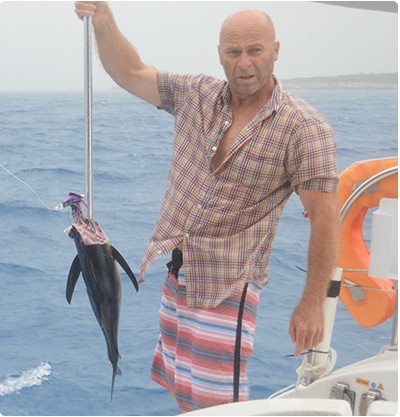
Don’t bring sharks on board, no matter how small (or big). We let this below one go!
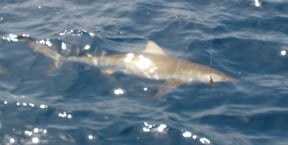
At the local base – buy a local fish identification chart. One time while fishing off the dinghy just before dark we caught and threw a bunch of fish back because they looked too ugly to eat. Turns out they were known by the locals as the best-eating fish in the local area. Fortunately, we’d kept a few and from our ID chart left on the sailboat, we learned this and were able to feed 2 boats that night. The next night we caught 10 squid and had the most delicious Calamari dinner. Wow! We were heroes!
Before you head out, make sure you have a fishing rod holder and some ability to fix it to the railings or stantions.
Learn to tie the Palomar fishing knot. Nylon or Dacron line is intolerant of any other knot.
And the yucky part for some – learn to fillet a fish. There are some very neat ways and some hacking ways. Don’t serve up hacked-up fish fillets.
Here are a couple of filleting how-to videos
Tuna: https://www.youtube.com/watch?v=olXOTddo3gA
Mahi Mahi: https://www.youtube.com/watch?v=1W1f3gf58s0
Catching the fish. You’ll need to stop the boat once a fish is online. There are a couple of ways to do this, the easiest is to heave to. i.e. tack the boat but not the head sail – leave it backwinded. Then let out the mainsail. Now as the boat comes to a stop, slowly turn the wheel all the way to windward and lock it. The other is to furl in the head sail and loosen off the main. Or you can even furl both the main and head sail. You’ll need to ensure that your crew can do this as you’ve got a potential dinner to attend to.
| Anecdote: One time sailing from Iles des Saints back to Guadeloupe Island we caught two decent-sized tuna. We proceeded to eat the most beautiful sashimi 6 times in a row – lunch – dinner – breakfast – lunch – dinner – breakfast. Restaurant speaking, it was probably $500 in sashimi. Luckily we’d prepared and already had the Wasabi and Soy on board. Ever had croissants, eggs and sashimi for breakfast? |
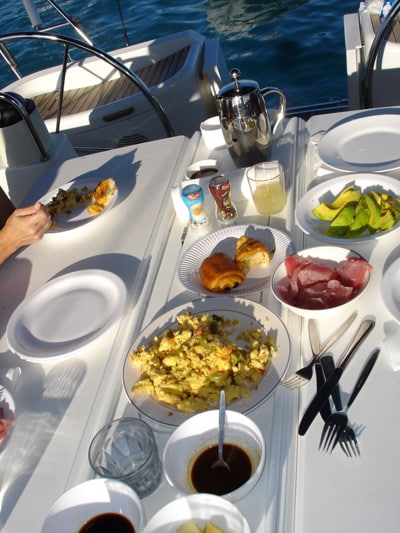
Embedded here is a YouTube video on how to fillet a fish. The only thing to change here is to cut away from your hand not towards it. Notice also that they are careful to cut over the rib cage and not into the stomach. This leaves a clean fillet. Once you have the fillet off, lie it flat skin side down, put your fingers on the tail end, and run the fillet knife in one movement under the fillet and on top of the skin. It will come away in one movement.
And finally, try to be the one and only captain who hasn’t backed up over the fishing line and wrapped it around the prop. Reel it in BEFORE you get into port. We suggest the “knot in the handkerchief” method – meaning to tie a ribbon or something on the helm whee so that when you start operating the helm to get into port or an anchorage, there it is – a big notice from your past self to your future-self to WIND IN THE FISHING REEL.
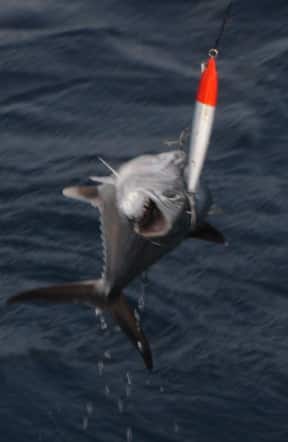
You can learn more in the Bareboat Charter Online Course....
The Bareboat Charter online sailing course is your go-to resource for planning an unforgettable sailing vacation. This comprehensive online course equips you with all the necessary skills and knowledge to successfully charter a yacht. Upgrade to the Bareboat Charter Master bundle of courses to fully prepare for near-coastal sailing and sailing charters.
